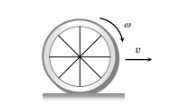Rigid Bodies: Translational Motion And Rotational Motion - Practice Questions & MCQ
Quick Facts
-
23 Questions around this concept.
Solve by difficulty
A mathematical line about a body in combined translation and rotation can be conceived in pure rotation at that instant and is called
If a body is moving such that a line drawn between any two of its internal points remains parallel to itself then the motion is called
A train is moving slowly at 2m/s next to a railway platform. A man 1.5m tall, alights from the train such that his feet are fixed on the ground. Talking him to be a rigid body, the instantaneous angular velocity (in rad/sec) is
A) 1.5
B) 2
C) 2.5
D) 3
Latest: Free All-India JEE Main 2026 Mock Test - Attempt Now
JEE Main Sample Papers: Physics | Chemistry | Maths | Top 30 Repeated Questions
JEE Main QP & Mock: Previous 10 Year Questions | Chapter Wise PYQs | Mock test Series
JEE Main: Last Five Year Analysis (2021-2025)
Concepts Covered - 2
-
Pure Translational motion-
If each particle of it has the same velocity/acceleration at a particular instant of time then A body is said to have pure translational motion.

-
Slipping-
It is a motion in which the body slides on a surface without rotation.
Example- Motion of a wheel on a frictionless surface.

Here friction between the body and surface =f= 0
Wheel possess only translatory kinetic energy
i.e., $-K_T=\frac{1}{2} m v^2$
-
Pure rotational motion-
When a body rotates such that its axis of rotation does not move then that body is said to have pure rotational motion.
In pure rotational motion, each particle of the body has the same angular velocity/acceleration about its axis of rotation at a particular instant of time.
Example- Spinning of the wheel about a fixed axis

Here axis of rotation of a wheel is fixed.
Here body possesses only rotatory kinetic energy.
$
\text { I.e } K_R=\frac{1}{2} I \omega^2
$
Here Rotational angular momentum $=\vec{L}=I \vec{w}$
Where $I=$ Moment of inertia about a fixed axis of rotation
$\omega=$ angular velocity of rotation
Another example is the motion of blades of a fan
-
Combined rotation and translation motion
In this type of motion, the body is having both rotation and translation motion.
-
Rolling
In the case of rolling motion, a body rotates about a fixed axis, and the axis of rotation also moves.
Example- Rolling of football on the ground

Here friction between the body and surface = $f \neq 0$
-
Kinetic energy-
The total kinetic energy of the body is the sum of both translational and rotational kinetic energy.
$
K_{n e t}=K_T+K_R=\frac{1}{2} m V^2+\frac{1}{2} I \omega^2
$
Using $V=\omega R$ and $I=m K^2$$
K_{n e t}=K_T+K_R=\frac{1}{2} m V^2\left(1+\frac{K^2}{R^2}\right)
$2. Net Velocity at a point-
$
\vec{V}_{\text {net }}=\vec{V}_{\text {translation }}+\vec{V}_{\text {rotation }}
$
Where, $\vec{V}_{r o t}=r w$

Angular momentum is always calculated at a particular point.
The net Angular momentum of a body is the sum of angular momentum due to both translational and rotational motion.
$\begin{aligned} \vec{L} & =L_{\text {com }}+m\left(\vec{r} \times v_{\text {com }}\right) \\ \Rightarrow \vec{L} & =I_{\text {com }} \vec{\omega}+m\left(\vec{r} \times v_{\text {com }}\right)\end{aligned}$
Where $L_{com}$ represents the angular momentum of the body about the centre of mass and r is the position vector about which we have to calculate the angular momentum.
Study it with Videos
"Stay in the loop. Receive exam news, study resources, and expert advice!"


